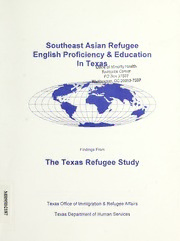
Southeast Asian Refugee English Proficiency and Education in Texas: Findings from the Texas Refugee Study PDF
Preview Southeast Asian Refugee English Proficiency and Education in Texas: Findings from the Texas Refugee Study
Southeast Asian Refugee & English Proficiency Education '11 ^®&lcpGf Health Findings From The Texas Refugee Study Texas Office of Immigration & Refugee Affairs Texas Department of Human Services In administering its programs, the Texas Department of Human Services does not discriminate, directly orthrough contractual or other arrangements, on the grounds of race, color, national origin, age, sex, disability, political beliefs, or religion. i • ' I ~ \S 4 I c_> Southeast Asian Refugee & English Proficiency Education In Texas Findings From The Texas Refugee Study & Texas Office ofImmigration Refugee Affairs Texas Department ofHuman Services Eric H. Taylor Lisa S. Barton The Texas Refugee Study Interviewer Managers CarmenL. Cutter, Steven Phuc Hoang, Khin Thayravahn, Eugene A Barg, Michael W. Ayele Interviewers MichaelW. Ayele, Eugene A. Barg, Boris Belyi, Goitom Bisrat, Khoi TienBui, Wing Cam, ChyDuong Do, Tue Quang Dinh, Hi Thi Duong, Enguday Geberhiwot, Sally Gribcova, Martin QuachHuynhHa, StevenP. Hoang, SavannKruoch, ThornVanLuong, VanH. Ly, TinaNguyen, Van-KhanhT. Nguyen, Abdul H. Osman, Lee Pham, Paul P. Phongsy, PhouthaPhothisane, Chantharin Saukam, SothyPin Saukam, Mulugeta Sishagn, Valentin Tamarchenko, KhinThayravanh, Stephen G. Tran, Thu T. Vu, Hanh C. Vuong Interviewer Training University ofTexas, Office ofSurvey Research Data Processing AdrianaHernandez, Jennifer Everett, and Lanita Vega Special thanks to: Governor AnnRichards Kassahun Bisrat, Bob Fleming, Ngoc-Linh Nguyen, YMCA ofGreater Houston, Refugee Services Alliance, Texas Center for Employment Services, Thuc Nguyen, Bill Holland, and Phon A. Nguyenkhoa Eric H. Taylor Principle Investigator Director ofResearch Marguerite Rivera Houze Director & Texas Office ofImmigration Refugee Affairs TABLE OF CONTENTS Introduction „ „ 1 & English Proficiency Education and: Income....... 3 Mammogram Screenings 7 Smoking 9 Citizenship 11 Driver's License., 13 Quality ofLife, Expectation ofU S Life & Future 15 Learning English & Making Money 17 , Tax Revenues and EnglishProficiency, 19 , Data Analysis Appendices A. Texas Refugee Study Methodology 21 B. Variables 24 C. English Proficiency and Educational Levels 28 D. Income 30 E. Mammogram Screenings 35 F. Smoking 37 G. Citizenship 39 H. Driver's License 41 & I. Quality ofLife, Expectation ofU.S. Life Future 43 J. English Proficiency & Income Path Analysis 46 K. Tax Revenues, ESL Costs, & Calculations for Investment Returns 48 References...., 53 , INTRODUCTION This is the first in a series ofreports about Texas's refugees. SoutheastAsian Refugee & EnglishProficiency Education is an analysis ofmore than 1,000 Vietnamese and Laotian refugee interviews. The interviews were part ofthe Texas Refugee Study, Texas's largest study ofrefugees ever (seeMethodology, Appendix A). The findings ofthe study are blended with other research and information to better understand the Southeast Asian refugees' experience in the U.S.. The resettlement ofSoutheast Asian refugees in the U.S. began in 1975 when many Vietnamese, Laotians, and Cambodians were forced to flee their home country as a result ofpersecution or a well-founded fear ofpersecution. U.S. government policy permitted continued immigration ofSoutheast Asians in an effort to reunite refugees with their family members. In addition to the Southeast Asians resettled in Texas by the State Department, thousands ofindividuals and their families have migrated to Texas from other states. This migration occurred, in part, due to the lure ofTexas's fishing industry in the 1980's and also because ofTexas's warm climate. Although the estimates ofthe number ofrefugees in Texas vary, there are approximately 40,000 Southeast Asian refugees in Houston and about 100,000 throughout the state. Many Southeast Asian refugees have experienced loss and tragedy in their native homeland. Their struggle included flight from their countries by boat or on foot and then detention at camps in countries offirst asylum. After being granted refugee status, the Southeast Asian refugees arrived in the U.S. faced with another struggle. This time the struggle was to adapt to a new culture, to understand a new world, and to make a better life. What defines "a better life" is different for everyone, but money, health, rights, and mobility can be considered among the most important. Two other elements that help make life better are education and communicating with others in society. This report relates the latter two - education and, in the case ofSoutheast Asian refugees, English proficiency - to other factors contributing to an improved life. The levels ofeducation and English proficiency vary widely among Southeast Asian refugees. The first group ofVietnamese to arrive in the U.S. in 1975 were urbanized or the "elite," and they were typically more educated than people from rural areas. Since that time the educational level ofnew Southeast Asian refugees has varied from no education to college-degreed, but on average this population has about the equivalent ofa high school education (see Appendix C). Once in the U.S., about one third ofSoutheast Asians have gone to public schools or college. English proficiency levels are also widely varied among Southeast Asian refugees (see Appendix C). Some learned English in their country oforigin, but the vast majority learned their English here in the U.S.. Individuals who enrolled in public school or college are at a great advantage because English has become a part oftheir daily education. l Others have taken adult English as a Second Language (ESL) courses to improve their English. Many have learned English in U.S. schools, by reading newspapers, magazines or TV books, by talking and listening to people in the U.S., and from watching or listening to the radio There are others who have learned almost no English. What follows is an examination ofthe relationships English proficiency and education have with Southeast Asian refugees' income, mammogram screenings, smoking, citizenship, possession ofa driver's license, and self-reported quality oflife measures among Southeast Asians living in Houston, Texas. 2
